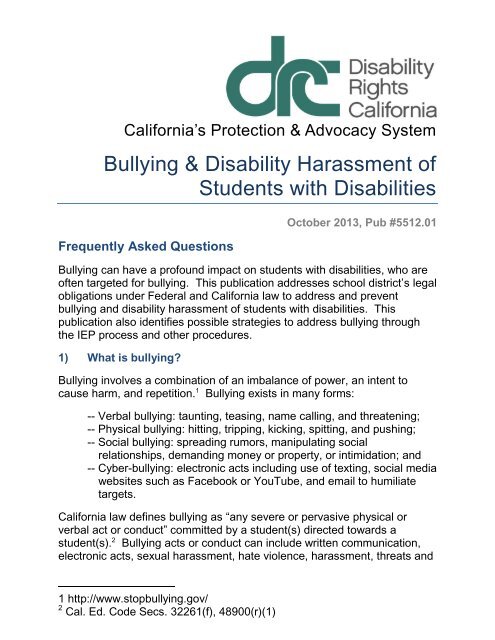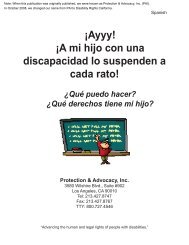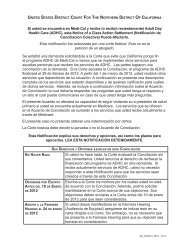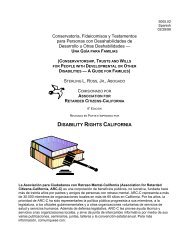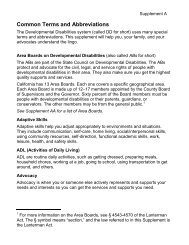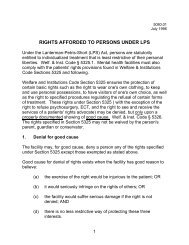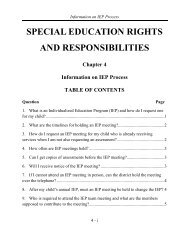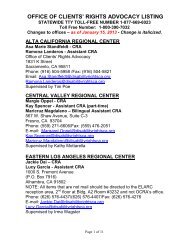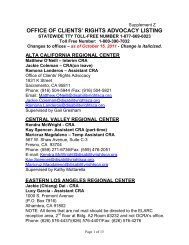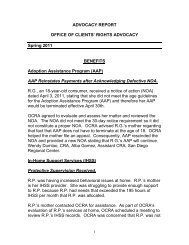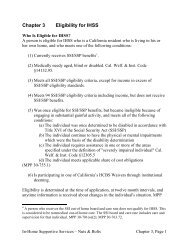Bullying & Disability Harassment of Students with Disabilities
Bullying & Disability Harassment of Students with Disabilities
Bullying & Disability Harassment of Students with Disabilities
Create successful ePaper yourself
Turn your PDF publications into a flip-book with our unique Google optimized e-Paper software.
California’s Protection & Advocacy System<br />
<strong>Bullying</strong> & <strong>Disability</strong> <strong>Harassment</strong> <strong>of</strong><br />
<strong>Students</strong> <strong>with</strong> <strong>Disabilities</strong><br />
Frequently Asked Questions<br />
October 2013, Pub #5512.01<br />
<strong>Bullying</strong> can have a pr<strong>of</strong>ound impact on students <strong>with</strong> disabilities, who are<br />
<strong>of</strong>ten targeted for bullying. This publication addresses school district’s legal<br />
obligations under Federal and California law to address and prevent<br />
bullying and disability harassment <strong>of</strong> students <strong>with</strong> disabilities. This<br />
publication also identifies possible strategies to address bullying through<br />
the IEP process and other procedures.<br />
1) What is bullying?<br />
<strong>Bullying</strong> involves a combination <strong>of</strong> an imbalance <strong>of</strong> power, an intent to<br />
cause harm, and repetition. 1 <strong>Bullying</strong> exists in many forms:<br />
-- Verbal bullying: taunting, teasing, name calling, and threatening;<br />
-- Physical bullying: hitting, tripping, kicking, spitting, and pushing;<br />
-- Social bullying: spreading rumors, manipulating social<br />
relationships, demanding money or property, or intimidation; and<br />
-- Cyber-bullying: electronic acts including use <strong>of</strong> texting, social media<br />
websites such as Facebook or YouTube, and email to humiliate<br />
targets.<br />
California law defines bullying as “any severe or pervasive physical or<br />
verbal act or conduct” committed by a student(s) directed towards a<br />
student(s). 2 <strong>Bullying</strong> acts or conduct can include written communication,<br />
electronic acts, sexual harassment, hate violence, harassment, threats and<br />
1 http://www.stopbullying.gov/<br />
2 Cal. Ed. Code Secs. 32261(f), 48900(r)(1)
<strong>Bullying</strong> & <strong>Disability</strong> <strong>Harassment</strong> <strong>of</strong> <strong>Students</strong> <strong>with</strong> <strong>Disabilities</strong><br />
intimidation. 3 For an act to be bullying these acts have the effect <strong>of</strong>, or<br />
could be reasonably predicted to result in:<br />
- Fear <strong>of</strong> physical harm or harm to property<br />
- Detrimental effect on physical or mental health<br />
- Interference <strong>with</strong> academic performance<br />
- Interference <strong>with</strong> participation in and benefitting from school<br />
activities, services and privileges. 4<br />
2) What is disability harassment?<br />
Department <strong>of</strong> Education Office <strong>of</strong> Civil Rights has stated that disability<br />
harassment is conduct that creates a hostile environment which limits<br />
people <strong>with</strong> disabilities from participating in or benefiting from school<br />
activities or services. 5 <strong>Harassment</strong> can be physical or verbal abuse and<br />
intimidation. <strong>Disability</strong> harassment, unlike bullying, may also include<br />
conduct that is not directed at a specific target, is not motivated by intent to<br />
cause harm, and involves isolated incidents. 6 However, bullying can be<br />
disability harassment if the bullying is on the basis <strong>of</strong> disability and/or<br />
targets people <strong>with</strong> disabilities. <strong>Disability</strong> harassment can be perpetrated<br />
by students and peers, and even by school employees, such as teachers<br />
and administrators. 7<br />
3) What laws govern bullying and disability harassment at school?<br />
<strong>Bullying</strong>, disability harassment, and anti-discrimination laws<br />
Under federal law, Section 504 <strong>of</strong> the Rehabilitation Act <strong>of</strong> 1973 and the<br />
Americans <strong>with</strong> <strong>Disabilities</strong> Act <strong>of</strong> 1990 prohibit discrimination on the basis<br />
<strong>of</strong> disability by school districts receiving federal funds and by governmental<br />
entities. <strong>Bullying</strong> and disability harassment can be a form <strong>of</strong> discrimination<br />
on the basis on disability. The U.S. Department <strong>of</strong> Education Office <strong>of</strong> Civil<br />
Rights has stated that disability harassment is a form <strong>of</strong> discrimination<br />
which violates Section 504 <strong>of</strong> the Rehabilitation Act <strong>of</strong> 1973 and Title II <strong>of</strong><br />
the Americans <strong>with</strong> <strong>Disabilities</strong> Act. 8<br />
3 Cal. Ed. Code Secs. 48900(r)(1), 48900.2, 48900.3, 48900.4.<br />
4 Cal. Ed. Code Secs. 32261(f), 48900(r)(1).<br />
5 http://www2.ed.gov/about/<strong>of</strong>fices/list/ocr/letters/colleague-201010.pdf<br />
6 http://www2.ed.gov/about/<strong>of</strong>fices/list/ocr/letters/colleague-201010.pdf<br />
7 http://www2.ed.gov/about/<strong>of</strong>fices/list/ocr/docs/disabharassltr.html<br />
8 http://www2.ed.gov/about/<strong>of</strong>fices/list/ocr/docs/disabharassltr.html<br />
2
<strong>Bullying</strong> & <strong>Disability</strong> <strong>Harassment</strong> <strong>of</strong> <strong>Students</strong> <strong>with</strong> <strong>Disabilities</strong><br />
California law also prohibits discrimination on the basis <strong>of</strong> disability in<br />
schools. 9 All pupils have the right to participate fully in the educational<br />
process, free from discrimination and harassment. California's public<br />
schools have an affirmative obligation to combat racism, sexism, and other<br />
forms <strong>of</strong> bias, and a responsibility to provide equal educational opportunity.<br />
<strong>Harassment</strong> on school grounds directed at an individual on the basis <strong>of</strong><br />
personal characteristics or status creates a hostile environment and<br />
jeopardizes equal educational opportunity as guaranteed by the California<br />
Constitution and the United States Constitution 10 .<br />
A school has notice <strong>of</strong> harassment if a responsible employee, such as a<br />
teacher or administrator, knew about the harassing conduct or would have<br />
known about the conduct if they were acting reasonably. School districts<br />
have an obligation to address discriminatory harassment that they know<br />
about, or reasonably should have known about. 11<br />
<strong>Bullying</strong> and Individuals <strong>with</strong> <strong>Disabilities</strong> Education Act<br />
Furthermore, under the Individuals <strong>with</strong> <strong>Disabilities</strong> Education Act (IDEA),<br />
school districts have a responsibility to provide free and appropriate public<br />
education (FAPE) to students <strong>with</strong> disabilities who are eligible for special<br />
education. The U.S. Department <strong>of</strong> Education Office <strong>of</strong> Civil Rights has<br />
stated that disability harassment may decrease students <strong>with</strong> disabilities’<br />
ability to benefit from public education and deny them <strong>of</strong> their right to<br />
FAPE. 12<br />
4) What are the school district’s responsibilities <strong>with</strong> regards to<br />
addressing bullying and disability harassment at school?<br />
Hostile learning environment<br />
School districts may violate federal law when peer harassment based on<br />
race, color, national origin, sex, or disability is sufficiently serious that it<br />
creates a hostile environment and such harassment is encouraged,<br />
tolerated, not adequately addressed, or ignored by school employees. 13 A<br />
number <strong>of</strong> courts have held that severe and pervasive harassment on the<br />
9 Cal. Ed. Code Sec. 220.<br />
10 Cal. Ed. Code Sec. 201(a)-(c).<br />
11 See footnote 9,<br />
http://www2.ed.gov/about/<strong>of</strong>fices/list/ocr/letters/colleague-201010.pdf<br />
12 http://www2.ed.gov/about/<strong>of</strong>fices/list/ocr/docs/disabharassltr.html<br />
13 34 C.F.R. parts 100, 104, and 106.<br />
3
<strong>Bullying</strong> & <strong>Disability</strong> <strong>Harassment</strong> <strong>of</strong> <strong>Students</strong> <strong>with</strong> <strong>Disabilities</strong><br />
basis <strong>of</strong> disability may create a hostile learning environment in violation <strong>of</strong><br />
the ADA and Section 504 <strong>of</strong> the Rehabilitation Act. 14 <strong>Harassment</strong> creates a<br />
hostile environment when the conduct is sufficiently severe, pervasive, or<br />
persistent so as to interfere <strong>with</strong> or limit a student’s ability to participate in<br />
or benefit from the services, activities, or opportunities <strong>of</strong>fered by a school.<br />
Discipline<br />
Under California law, students can be suspended or expelled if they<br />
engage in bullying. This includes cyberbullying. 15<br />
A student can be suspended or recommended for expulsion if the<br />
superintendent or the principal <strong>of</strong> the school determines that the student<br />
has intentionally engaged in harassment, threats or intimidation "that is<br />
sufficiently severe or pervasive to have the actual and reasonably expected<br />
effect <strong>of</strong> materially disrupting class work, creating substantial disorder, and<br />
invading the rights <strong>of</strong> either school personnel or pupils by creating an<br />
intimidating or hostile educational environment." 16<br />
Anti-bullying policy<br />
California law requires school districts to adopt policies prohibiting<br />
discrimination, harassment, intimidation, and bullying in school. 17 School<br />
district must also adopt a complaint process for receiving and investigating<br />
complaints <strong>of</strong> discrimination, harassment, intimidation, and bullying. 18<br />
School district policy must establish a timeline to investigate and resolve<br />
complaints. 19 The policy should also provide an appeals process, in case<br />
parents disagree <strong>with</strong> the school district’s resolution <strong>of</strong> a complaint. 20<br />
Districts must ensure that people who report discrimination, harassment,<br />
intimidation, and bullying in school are protected from retaliation and their<br />
14 See, Guckenberger v. Boston University, 957 F. Supp. 306, 314 (D.<br />
Mass. 1997); Pell v. the Trustees <strong>of</strong> Columbia University, 1998 U.S. Dist.<br />
Lexis 407, 56 (S.D.N.Y. 1998); and Rick C. v. Lodi School District, 32,<br />
Individuals <strong>with</strong> <strong>Disabilities</strong> Education Law Report, 232.<br />
15 Cal. Ed. Code Sec. 48900.<br />
16 Cal. Ed. Code Sec. 48900.4.<br />
17 Cal. Ed. Code Sec. 234.1(a)<br />
18 Cal. Ed. Code Sec. 234.1(b)<br />
19 Cal. Ed. Code Sec. 234.1(b)(2)<br />
20 Cal. Ed. Code Sec. 234.1(b)(3)<br />
4
<strong>Bullying</strong> & <strong>Disability</strong> <strong>Harassment</strong> <strong>of</strong> <strong>Students</strong> <strong>with</strong> <strong>Disabilities</strong><br />
identity remains confidential, as appropriate. 21 Districts are also required to<br />
include in their complaint process, a requirement that school personnel<br />
take immediate steps to intervene, if they witness an act <strong>of</strong> discrimination,<br />
harassment, intimidation, or bullying, if it is safe to do so. 22<br />
You can request a copy <strong>of</strong> your school district’s discrimination, harassment,<br />
intimidation and bullying policy and complaint process; your school district<br />
should make this information available to you. If your primary language is<br />
not English, this information should be translated into your primary<br />
language. 23<br />
Priority for Interdistrict Transfer<br />
A parent <strong>of</strong> a student who is being bullied may request an interdistrict<br />
transfer. 24 California law provides that the student be given priority for<br />
interdistrict transfer, or special consideration for the creation <strong>of</strong> an<br />
interdistrict attendance agreement. 25 Priority and special consideration will<br />
be granted if the staff at the home district, or staff at the district into which<br />
transfer is requested, determine that the student has been bullied in the<br />
home district. 26<br />
5) How can parents tell if their child is being bullied?<br />
Pay attention to your child and any changes in behavior, mood, or<br />
appearance such as:<br />
- Changes in eating and sleeping habits<br />
- Dropping grades and academic performance<br />
- Avoiding school, truancy, tardiness or otherwise expressing dislike<br />
<strong>of</strong> school.<br />
- Evidence <strong>of</strong> physical altercations or injury, such as cuts, bruises,<br />
or torn clothing.<br />
- Depression, anxiety, loneliness, or low self-esteem.<br />
21 Cal. Ed. Code Sec. 234.1(f)<br />
22 Cal. Ed. Code Sec. 234.1(b)(1)<br />
23 Cal. Ed. Code Sec. 234.1(c)<br />
24 Cal. Ed. Code Sec. 46600(b)<br />
25 Cal. Ed. Code Sec. 46600(b)<br />
26 Cal. Ed. Code Sec. 46600(b)<br />
5
<strong>Bullying</strong> & <strong>Disability</strong> <strong>Harassment</strong> <strong>of</strong> <strong>Students</strong> <strong>with</strong> <strong>Disabilities</strong><br />
Sometimes students <strong>with</strong> disabilities are not aware that they are being<br />
bullied, so it is important to communicate <strong>with</strong> your child, ask them about<br />
their relationships <strong>with</strong> their peers.<br />
6) How can parents use the IEP process to address bullying?<br />
If you suspect or have knowledge that your child <strong>with</strong> a disability is having<br />
issues <strong>with</strong> bullying in school, you should notify your school immediately.<br />
You may also want to request an IEP meeting. An IEP meeting is a good<br />
opportunity to speak <strong>with</strong> school staff about your concerns regarding<br />
bullying.<br />
If you believe that bullying may be having an impact on your child’s<br />
emotional and social well-being and/or academic performance, you may<br />
also wish to make a written request for assessment <strong>of</strong> your child’s mental<br />
and emotional condition. This assessment may assist you and the IEP<br />
team in identifying appropriate services to address the impact bullying has<br />
on your child and his/her education.<br />
At the IEP meeting, it is important to emphasize that bullying or disability<br />
harassment impacts your child’s ability to benefit from his education, and<br />
that it is necessary to address bullying in the IEP for your child to receive<br />
FAPE.<br />
There are many goals, accommodations, and services which can be<br />
incorporated into your child’s IEP to address bullying. Here are some<br />
examples <strong>of</strong> IEP goals and interventions which can address issues <strong>with</strong><br />
bullying:<br />
Building social skills. A student can learn about appropriate social<br />
interaction, and learn to identify inappropriate social interactions and<br />
bullying behavior. Sometimes students who are bullied do not know it<br />
is inappropriate to bully other students or they react aggressively to<br />
bullying.<br />
Developing positive interpersonal relationships. <strong>Students</strong> who<br />
are able to develop positive relationships and friendships more likely<br />
to have confidence and are better equipped to handle bullying or<br />
harassing behavior<br />
Developing self-advocacy skills. Children can learn appropriate<br />
responses to bullying, including how and when to notify appropriate<br />
adults, to say “Stop,” or walk away from or avoid stressful situations.<br />
6
<strong>Bullying</strong> & <strong>Disability</strong> <strong>Harassment</strong> <strong>of</strong> <strong>Students</strong> <strong>with</strong> <strong>Disabilities</strong><br />
Supervision or separation from bullies. The IEP can provide<br />
accommodations so that the student can be monitored or shadowed<br />
by school staff, separated from bullies, or to allow the student avoid<br />
stressful or charged situations or environments (for example,<br />
hallways or the back <strong>of</strong> the bus). However, be careful that these<br />
measures do not “punish” your child, place them in an overly<br />
restrictive environment, or deprive them <strong>of</strong> opportunities for positive<br />
peer interaction.<br />
Counseling or other supportive services. This can be counseling<br />
through a school psychologist or informal check-ins <strong>with</strong> a teacher,<br />
guidance counselor, or principal who the student can turn to when<br />
they are being bullied or harassed.<br />
Parent counseling and training. Parent counseling may help<br />
parents understand the special needs <strong>of</strong> their child, and help them<br />
acquire the skills that would allow them to support the implementation<br />
<strong>of</strong> the child’s IEP.<br />
Educating school staff and/or peers. School staff can be<br />
educated as to the school’s bullying policy and complaint and<br />
reporting procedures. If appropriate, staff can be educated to better<br />
understand and be sensitive to the student’s disability.<br />
This list is not exhaustive. Like any aspect <strong>of</strong> an IEP, goals,<br />
accommodations, and services should be designed for your child’s unique<br />
needs.<br />
7) What procedures are available to obtain relief when a school<br />
district fails to protect a student <strong>with</strong> a disability against<br />
bullying?<br />
If the school district is not following special education laws or procedures or<br />
has not implemented what was agreed upon in your child’s IEP, you may<br />
file a compliance complaint <strong>with</strong> the California Department <strong>of</strong> Education.<br />
However, if you have a disagreement <strong>with</strong> the school district regarding<br />
what should go into your child’s IEP, you may wish to request a due<br />
process hearing.<br />
You may also file a complaint <strong>with</strong> the Office <strong>of</strong> Civil Rights (OCR) <strong>with</strong> the<br />
U.S. Department <strong>of</strong> Education regarding allegations <strong>of</strong> discrimination in<br />
7
<strong>Bullying</strong> & <strong>Disability</strong> <strong>Harassment</strong> <strong>of</strong> <strong>Students</strong> <strong>with</strong> <strong>Disabilities</strong><br />
education on the basis <strong>of</strong> disability that may constitute a violation <strong>of</strong> Section<br />
504 <strong>of</strong> the Rehabilitation Act.<br />
You can find more information regarding due process and complaint<br />
procedures in the Special Education Rights and Responsibilities<br />
publication, available online at:<br />
http://www.disabilityrightsca.org/pubs/504001SERR.htm<br />
8
<strong>Bullying</strong> & <strong>Disability</strong> <strong>Harassment</strong> <strong>of</strong> <strong>Students</strong> <strong>with</strong> <strong>Disabilities</strong><br />
[Date]<br />
To:<br />
[School Principal’s name]<br />
[Name <strong>of</strong> School]<br />
[School Address]<br />
From: [Parent’s name]<br />
[Address]<br />
Re:<br />
[Name <strong>of</strong> student]<br />
Grade [Grade Level]<br />
DOB: [Student’s birth date]<br />
Dear [School Principal]:<br />
I am writing to inform you that my child, [name <strong>of</strong> student], is being bullied<br />
and harassed at school. My child is a student <strong>with</strong> a disability. My child<br />
has the following disability: [specify disability]. I believe that this<br />
harassment is based on his/her disability.<br />
(S)he has been harassed by [name <strong>of</strong> harasser(s)]. This has occurred on<br />
[date or approximate period <strong>of</strong> time], when [describe incident(s) in as much<br />
detail as possible].<br />
When this happened [name <strong>of</strong> witness(es)] witnessed it and [their<br />
response]. My child spoke to [names <strong>of</strong> school staff] about this incident(s)<br />
on [date or approximate period <strong>of</strong> time]. Their response was [describe<br />
school staff response]. I became aware <strong>of</strong> this incident(s) when [describe<br />
how you were notified].<br />
This bullying and disability harassment has affected my child’s ability to<br />
access education and has resulted in the following negative consequences:<br />
9
<strong>Bullying</strong> & <strong>Disability</strong> <strong>Harassment</strong> <strong>of</strong> <strong>Students</strong> <strong>with</strong> <strong>Disabilities</strong><br />
[Describe effects, including physical/emotional injuries or effects, need for<br />
medical/psychological treatment, and impact on academic or school activity<br />
attendance, participation, and performance].<br />
As you may know, my child is a student <strong>with</strong> a disability, who has an<br />
Individualized Education Plan (IEP)/504 Plan [select, if appropriate].<br />
Federal and State law protect the rights <strong>of</strong> students <strong>with</strong> disabilities to be<br />
free <strong>of</strong> bullying and harassment based on disability, which interferes <strong>with</strong> or<br />
denies opportunity to participate in or benefit from education. Furthermore,<br />
California law requires School Districts to adopt policies that prohibit<br />
discrimination, harassment and bullying, to create a complaint process to<br />
receive and investigate complaints <strong>of</strong> discrimination, harassment and<br />
bullying, and to make this policy available to parents and students.<br />
I request to receive a copy <strong>of</strong> the District’s policy on bullying and<br />
harassment. I request that you investigate this issue and resolve it as soon<br />
as possible. Please let me know in writing, the results <strong>of</strong> your investigation,<br />
and what steps you have taken to address this problem, and to ensure it<br />
does not happen in the future.<br />
I would also like to request a IEP/504 Plan [choose one, if applicable]<br />
meeting to be held as soon as possible in order to discuss possible<br />
accommodations, services, and/or supports in order to address this issue.<br />
Thank you for your prompt attention to this matter.<br />
[Parent’s Signature]<br />
[Date]<br />
10
<strong>Bullying</strong> & <strong>Disability</strong> <strong>Harassment</strong> <strong>of</strong> <strong>Students</strong> <strong>with</strong> <strong>Disabilities</strong><br />
[Date]<br />
To:<br />
From:<br />
California Department <strong>of</strong> Education<br />
Sharon Felix-Rochon, Director<br />
Office <strong>of</strong> Equal Opportunity<br />
1430 N Street, Suite 4206<br />
Sacramento, CA 95814<br />
[Parent’s name]<br />
[Parent’s Address]<br />
Dear Sir or Madam,<br />
I am writing to file a complaint against [name <strong>of</strong> school district] because I<br />
feel that my child, [name <strong>of</strong> student] has been wrongfully discriminated<br />
against on the basis <strong>of</strong> his/her disability.<br />
[Name <strong>of</strong> student] is in [grade level] at [name <strong>of</strong> school]. (S)he is a student<br />
<strong>with</strong> a disability; (s)he has [specify disability]. (S)he has an IEP/504 Plan<br />
[select, if applicable].<br />
[Name <strong>of</strong> student] has been bullied and harassed because <strong>of</strong> his/her<br />
disability at school. This occurred on [date or approximate period <strong>of</strong> time],<br />
when [describe incident(s) in as much detail as possible].<br />
When this happened, [name <strong>of</strong> witness(es)] heard or saw it and [their<br />
response]. My child spoke to [name(s) and title(s) <strong>of</strong> school staff] about<br />
these incidents on [date or approximate period <strong>of</strong> time] and their response<br />
was to [describe school staff response]. I became aware <strong>of</strong> this incident<br />
when [describe how you were notified].<br />
I believe that this harassing conduct is based on disability because<br />
[describe the relationship between the harassment and the student’s<br />
disability].<br />
This disability harassment has created a hostile learning environment<br />
which has interfered <strong>with</strong> my child’s ability to access education and has<br />
resulted in the following negative consequences: [Describe effects,<br />
including physical/emotional injuries or effects, need for<br />
medical/psychological treatment, and impact on academic and/or school<br />
activity attendance, participation, and performance].<br />
On [date you sent letter to school district], I filed a written complaint <strong>with</strong> the<br />
school district and I requested that they investigate and resolve the matter<br />
11
<strong>Bullying</strong> & <strong>Disability</strong> <strong>Harassment</strong> <strong>of</strong> <strong>Students</strong> <strong>with</strong> <strong>Disabilities</strong><br />
as soon as possible. In response, the school district has [describe school<br />
district’s response]. I believe they have failed in their obligation to protect<br />
my child from discrimination and harassment based on disability because,<br />
[describe why their response fails to adequately address disability<br />
harassment].<br />
Section 504 <strong>of</strong> the Rehabilitation Act <strong>of</strong> 1973, Title II <strong>of</strong> the Americans <strong>with</strong><br />
<strong>Disabilities</strong> Act <strong>of</strong> 1990, and California Education Code sections 200, 201,<br />
220, 234, and 234.1 protect the rights <strong>of</strong> students <strong>with</strong> disabilities to be free<br />
<strong>of</strong> discrimination and harassment based on disability, which interferes <strong>with</strong><br />
or denies opportunity to participate in or benefit from education.<br />
Furthermore, under the Individuals <strong>with</strong> Education Act, disability<br />
harassment may result in a failure by a school district to provide Free and<br />
Appropriate Public Education.<br />
In order to resolve this complaint, I am asking for the following remedies:<br />
[indicate what you want the school district to do as a result <strong>of</strong> your<br />
complaint, i.e. counseling for student, compensatory services, training on<br />
discrimination and disability harassment for staff/students, modifications to<br />
the school district’s policies, etc.].<br />
I have enclosed [indicate any relevant documents/evidence, including<br />
letters and other communications, decisions, etc].<br />
Please feel free to contact me regarding this complaint. Thank you for your<br />
prompt attention to this matter.<br />
Sincerely,<br />
[Signature]<br />
[Date]<br />
12
<strong>Bullying</strong> & <strong>Disability</strong> <strong>Harassment</strong> <strong>of</strong> <strong>Students</strong> <strong>with</strong> <strong>Disabilities</strong><br />
[Date]<br />
To:<br />
From:<br />
San Francisco Office<br />
Office for Civil Rights<br />
U.S. Department <strong>of</strong> Education<br />
50 Beale Street, Suite 7200<br />
San Francisco, CA 94105-1813<br />
[Parent’s name]<br />
[Parent’s Address]<br />
Dear Sir or Madam,<br />
I am writing to file a complaint against [name <strong>of</strong> school district] because I<br />
feel that my child, [name <strong>of</strong> student], has been wrongfully discriminated<br />
against on the basis <strong>of</strong> his/her disability.<br />
[Name <strong>of</strong> student] is in [grade level] at [name <strong>of</strong> school]. (S)he is a student<br />
<strong>with</strong> a disability; (s)he has [specify disability]. (S)he has an IEP/504 Plan<br />
[select, if applicable].<br />
[Name <strong>of</strong> student] has been bullied and harassed because <strong>of</strong> his/her<br />
disability at school. This occurred on [date or approximate period <strong>of</strong> time],<br />
when [describe incident(s) in as much detail as possible].<br />
When this happened, [name <strong>of</strong> witness(es)] heard or saw it and [their<br />
response]. My child spoke to [name(s) and title(s) <strong>of</strong> school staff] about<br />
these incidents on [date or approximate period <strong>of</strong> time] and their response<br />
was [describe school staff response]. I became aware <strong>of</strong> this incident when<br />
[describe how you were notified].<br />
I believe that this harassing conduct is based on disability because<br />
[describe the relationship between the harassment and the student’s<br />
disability].<br />
This disability harassment has created a hostile learning environment<br />
which has interfered <strong>with</strong> my child’s ability to access education and has<br />
resulted in the following negative consequences: [Describe effects,<br />
including physical/emotional injuries or effects, need for<br />
medical/psychological treatment, and impact on academic and/or school<br />
activity attendance, participation, and performance].<br />
13
<strong>Bullying</strong> & <strong>Disability</strong> <strong>Harassment</strong> <strong>of</strong> <strong>Students</strong> <strong>with</strong> <strong>Disabilities</strong><br />
On [date you sent letter to school district], I filed a written complaint <strong>with</strong> the<br />
school district and I requested that they investigate and resolve the matter<br />
as soon as possible. In response, the school district has [describe school<br />
district’s response]. I believe they have failed in their obligation to protect<br />
my child from discrimination and harassment based on disability because,<br />
[describe why their response fails to adequately address disability<br />
harassment].<br />
Section 504 <strong>of</strong> the Rehabilitation Act <strong>of</strong> 1973, Title II <strong>of</strong> the Americans <strong>with</strong><br />
<strong>Disabilities</strong> Act <strong>of</strong> 1990 protect the rights <strong>of</strong> students <strong>with</strong> disabilities to be<br />
free <strong>of</strong> discrimination and harassment based on disability, which interferes<br />
<strong>with</strong> or denies opportunity to participate in or benefit from education.<br />
Furthermore, under the Individuals <strong>with</strong> Education Act, disability<br />
harassment may result in a failure by a school district to provide Free and<br />
Appropriate Public Education.<br />
In order to resolve this complaint, I am asking for the following remedies:<br />
[indicate what you want the school district to do as a result <strong>of</strong> your<br />
complaint, i.e. counseling for student, compensatory services, training on<br />
discrimination and disability harassment for staff/students, modifications to<br />
the school district’s policies, etc.].<br />
I have enclosed [indicate any relevant documents/evidence, including<br />
letters and other communications, decisions, etc].<br />
Please feel free to contact me regarding this complaint. Thank you for your<br />
prompt attention to this matter.<br />
Sincerely,<br />
[Signature]<br />
[Date]<br />
14
<strong>Bullying</strong> & <strong>Disability</strong> <strong>Harassment</strong> <strong>of</strong> <strong>Students</strong> <strong>with</strong> <strong>Disabilities</strong><br />
<strong>Disability</strong> Rights California is funded by a variety <strong>of</strong> sources, for a complete<br />
list <strong>of</strong> funders, go to http://www.disabilityrightsca.org/<br />
Documents/List<strong>of</strong>GrantsAndContracts.html.<br />
15


